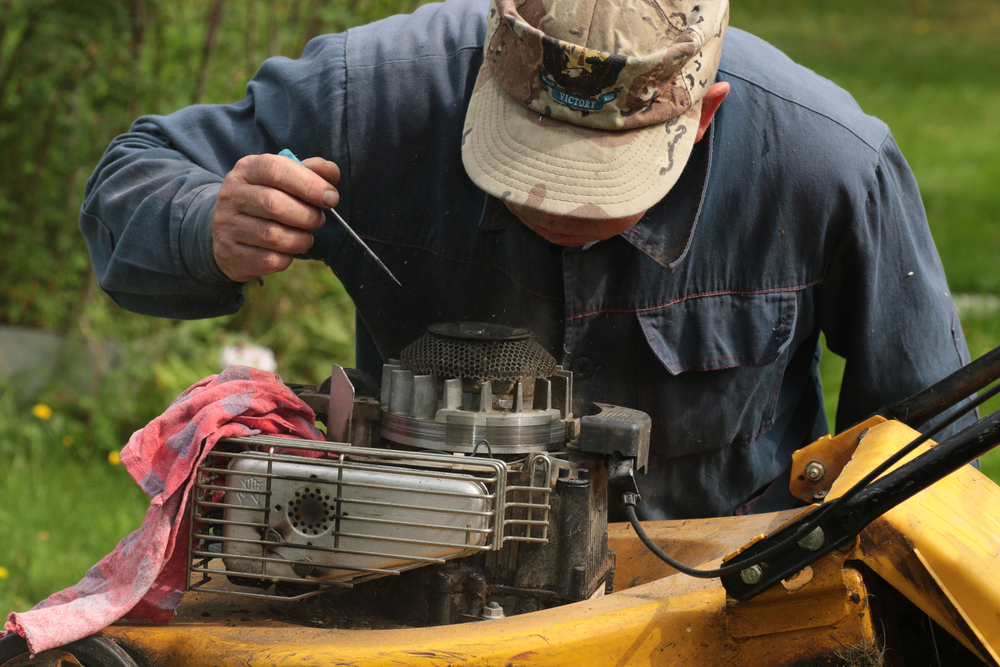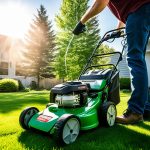A clean air filter keeps lawn mowers running efficiently and prevents costly engine damage. When dirt and debris clog the filter, the engine struggles to get proper airflow, leading to poor performance, increased fuel consumption, and potential overheating issues.
Regular cleaning of foam filters and careful maintenance of paper filters can extend their lifespan and maintain optimal engine performance. The process differs depending on the filter type, with foam filters requiring thorough washing and re-oiling, whilst paper filters need gentle cleaning to avoid damage.
This guide covers everything from identifying filter types to proper cleaning techniques and reassembly procedures. Understanding these maintenance steps helps prevent common problems like difficulty starting, reduced power output, and excessive smoke production that plague neglected mowers.
Understanding Lawn Mower Air Filters
Air filters serve as the first line of defence against dirt and debris entering your lawn mower’s engine, with different filter types requiring specific maintenance approaches. A clean air filter maintains the proper air-fuel ratio needed for optimal combustion and prevents premature engine wear.
Purpose of an Air Filter
The air filter prevents dirt and debris from entering the engine through the carburettor during operation. When grass cutting kicks up dust and particles, the filter blocks these contaminants before they reach internal engine components.
A properly functioning air filter maintains the critical air-fuel ratio of 14.7:1 required for efficient combustion. This precise mixture allows the engine to run smoothly and produce maximum power output.
Without adequate filtration, dirt particles act as abrasives inside the engine cylinders. These contaminants wear down piston rings, cylinder walls, and other moving parts rapidly. Clean air filtration extends engine life significantly by preventing this internal damage.
The filter also helps regulate airflow into the engine. Consistent air delivery supports stable engine performance across different operating conditions and loads.
Types of Lawn Mower Air Filters
Paper air filters consist of compressed fibres forming a web structure to trap particles. These filters handle fine dirt effectively but are more delicate and prone to damage during cleaning.
Paper filters typically serve as the main filtration element. However, cleaning them can over-compress the fibres, reducing effectiveness and potentially causing tears that allow dirt through.
Foam air filters offer greater durability and can withstand thorough cleaning procedures. These filters usually function as pre-filters, catching larger debris before it reaches the main paper element.
Foam filters require oil application after cleaning to trap particles effectively. The oil coating helps small particles stick to the foam material rather than passing through to the engine.
Some lawn mowers use combination systems with both foam pre-filters and paper main filters. This dual-stage approach provides superior protection by removing different sized particles at each stage.
How Dirty Air Filters Affect Engine Life
A dirty air filter restricts airflow, creating an overly rich fuel mixture that reduces combustion efficiency. This condition leads to incomplete fuel burning, carbon buildup, and reduced engine power.
Restricted airflow forces the engine to work harder to draw in adequate air for combustion. The increased strain on internal components accelerates wear patterns and reduces overall engine lifespan.
Dirty filters can cause starting difficulties as the engine struggles to achieve proper air-fuel mixing. Hard starting puts additional stress on the starter motor and ignition system components.
Fuel economy suffers when filters become clogged, as the engine compensates for poor airflow by running richer fuel mixtures. This inefficiency wastes fuel and increases operating costs over time.
Severely blocked filters may cause backfiring or overheating as combustion becomes irregular. These conditions can damage valves, pistons, and other expensive engine components if left unaddressed.
Preparation and Safety Precautions
Proper preparation and safety measures prevent accidents and make the cleaning process more efficient. Gathering the right tools beforehand and taking basic safety steps like disconnecting the spark plug wire protect both the person performing maintenance and the lawn mower itself.
Gathering Tools and Materials
The cleaning process requires specific tools and materials that should be collected before beginning work. A screwdriver will be needed to remove screws securing the air filter cover. Safety gloves protect hands from dirt and debris during handling.
Clean rags or paper towels are necessary for wiping down components and drying the filter after cleaning. A wash basin or sink provides space for cleaning foam filters thoroughly. Mild liquid dish detergent helps remove grease and dirt from foam elements.
For foam filters, 1-2 teaspoons of engine oil will be required for the re-oiling process after cleaning. Having a replacement filter available proves useful if the current filter cannot be cleaned adequately. Compressed air or an air duster can help remove loose debris from paper filters, though this should be used carefully to avoid forcing dirt into the engine.
Locating the Air Filter and Protective Shroud
The air filter housing sits near the top of the engine compartment, typically covered by a protective shroud or cover. This plastic or metal cover protects the air filter from external elements and secures it in place. Most covers are held by screws or clips that require removal for access.
The protective shroud may be rectangular or circular depending on the lawn mower model. Some covers have tabs or clips instead of screws for quick removal. The air filter housing beneath the cover contains the actual filter element.
Identifying the correct cover prevents accidentally removing other engine components. The owner’s manual provides specific locations for different mower models if the housing proves difficult to locate.
Disconnecting the Spark Plug Wire
The spark plug wire must be disconnected before beginning any maintenance work on the lawn mower. This prevents accidental engine starts during the cleaning process, which could cause injury or damage. The wire connects to the top of the spark plug and can be pulled off by gripping the boot rather than the wire itself.
Pull the boot straight up with a firm, steady motion to avoid damaging the connection. Some boots may require a slight twisting motion whilst pulling to release properly. The disconnected wire should be positioned away from the spark plug to prevent accidental contact.
The engine must be completely cool before beginning work. Allow at least 30 minutes after operation before starting maintenance. This prevents burns from hot engine components and allows time for all moving parts to stop completely.
Step-by-Step Cleaning Process
The cleaning process involves safely removing the air filter from its housing near the carburetor, then following different methods based on whether it’s foam or paper material. Foam filters require washing and oiling, whilst paper filters need gentle debris removal without water contact.
Removing the Air Filter
Turn off the engine and disconnect the spark plug wire for safety. Allow the engine to cool completely before beginning work.
Locate the air filter housing, which sits near the carburetor on most lawn mower engines. The housing typically has a cover held in place by clips, screws, or wing nuts.
Remove the fasteners and lift off the cover carefully. Some housings have a foam pre-filter wrapped around a paper main filter.
Take note of how the filters are positioned before removal. The foam filter usually sits on the outside, with the paper filter behind it.
Lift out each filter component separately. Handle paper filters with extra care as they tear easily when wet or handled roughly.
Cleaning and Inspecting a Foam Air Filter
Blow off loose dirt and debris using compressed air from an air gun. Work from multiple angles to remove as much surface contamination as possible.
Apply filter cleaner spray or mild degreaser liberally across all surfaces of the foam. Allow the cleaning solution to penetrate for 10-15 minutes to break down oil and stubborn dirt deposits.
Rinse the filter under running water, squeezing gently to work out embedded dirt and debris. Repeat the cleaning and rinsing process if the foam still appears dirty after the first cycle.
Squeeze out excess water without twisting or wringing the foam material. Press the filter between clean towels to remove additional moisture.
Allow the foam to air dry completely for at least 24 hours. A damp filter will not perform properly and can damage the engine.
Inspect the dried foam for tears, holes, or compressed areas. Small holes in pre-filters are acceptable, but main filters must be intact.
Cleaning and Inspecting a Paper Air Filter
Tap the paper filter gently against a hard surface to dislodge loose dirt and debris. Work carefully to avoid damaging the delicate paper fibres.
Use compressed air to blow from the reverse side of the filter first. This pushes dirt out through the front rather than deeper into the material.
Follow with gentle air blasts across the front surface to remove any remaining loose particles. Avoid directing high-pressure air straight into the filter face.
Never use water, cleaning solvents, or oil on paper filters. These substances will destroy the paper fibres and ruin the filter’s effectiveness.
Inspect the paper carefully for holes, tears, or areas where the pleats have collapsed. Hold the filter up to a light source to spot small damage.
Replace the paper filter immediately if any damage is visible. Damaged paper filters allow unfiltered air into the carburetor, causing engine wear.
Oiling the Foam Air Filter
Apply foam filter oil spray evenly across all surfaces of the clean, dry foam filter. Use only oil specifically designed for air filters, not motor oil or other substitutes.
Place the oiled filter inside a clean plastic bag and seal it. Squeeze and massage the bag to distribute oil throughout the foam’s interior.
Allow the filter to sit for 5-10 minutes so the oil can penetrate completely. Proper oil distribution is essential for effective dirt capture.
Add clean paper towels to the bag with the filter. Squeeze the bag again to absorb excess oil that could drip into the carburetor.
The properly oiled filter should feel slightly tacky but not dripping wet. Excess oil can foul the spark plug and cause starting problems.
Check that the foam has returned to its original colour and texture. A properly prepared foam filter is ready for installation back into the air filter housing.
Reassembly and Maintenance Tips
Proper reassembly prevents air leaks that can damage the engine. A consistent maintenance schedule keeps the air filter functioning effectively and extends mower lifespan.
Reinstalling the Air Filter and Shroud
Clean, dry filters must be positioned correctly before installation. Foam filters require complete drying for 24 hours after cleaning to prevent engine damage.
Paper filters should slide into their housing without forcing or bending. Check that the filter sits flush against all mounting surfaces. Any gaps allow unfiltered air to enter the engine.
Foam filters need proper oiling before installation. Apply filter oil evenly across the surface. Squeeze excess oil out using paper towels or a clean cloth.
The air filter shroud or cover requires careful alignment. Position the shroud over the filter housing and check that all mounting tabs line up correctly. Loose shrouds create air leaks that bypass the filtration system.
Tighten mounting screws or clips to the manufacturer’s specifications. Over-tightening can crack plastic housings. Under-tightening allows dirt to enter the engine compartment.
Reconnecting the Spark Plug Wire
The spark plug wire connects after all other maintenance is complete. Clean any dirt or oil from your hands before handling the wire connection.
Push the spark plug boot firmly onto the spark plug terminal. The boot should click into place and sit flush against the plug. A loose connection causes starting problems and poor engine performance.
Check that the wire routing matches the original path. Incorrect routing can cause the wire to contact hot engine surfaces or moving parts. This creates safety hazards and can damage the ignition system.
Test the connection by gently tugging on the boot. It should remain firmly attached to the spark plug. Replace worn or cracked spark plug wires immediately.
Regular Maintenance Schedule
Foam pre-cleaners require cleaning every 25 operating hours or monthly during active mowing season. Paper filters need replacement annually or after 300 operating hours.
Dusty conditions demand more frequent maintenance. Mowing dry grass, sandy soil, or during windy conditions increases filter contamination rates. Check filters bi-weekly during these conditions.
Maintenance intervals:
- Foam filters: Clean every 25 hours
- Paper filters: Replace every 300 hours or annually
- Dusty conditions: Check every 2 weeks
- Storage preparation: Clean before winter storage
Mark maintenance dates on a calendar or mower log. This prevents forgotten services that can damage the engine. Regular cleaning costs less than engine repairs from dirty filters.
When to Replace the Air Filter
Paper filters show replacement needs through visual inspection. Holes, tears, or compressed fibres indicate the filter cannot perform effectively.
Excessive dirt that won’t clean out with compressed air means replacement time. Multiple cleaning cycles reduce paper filter effectiveness even when they appear clean.
Foam filters need replacement when they begin falling apart or losing density. Stretched or cracked foam cannot trap particles properly. Oil-soaked foam that won’t clean indicates replacement time.
Pre-cleaners with small holes can continue service if they’re secondary filters. However, damaged primary filters require immediate replacement to protect engine components.
Replace both foam and paper filters simultaneously when your mower uses a dual-filter system. Mismatched filter conditions reduce overall filtration effectiveness and can damage the engine.





